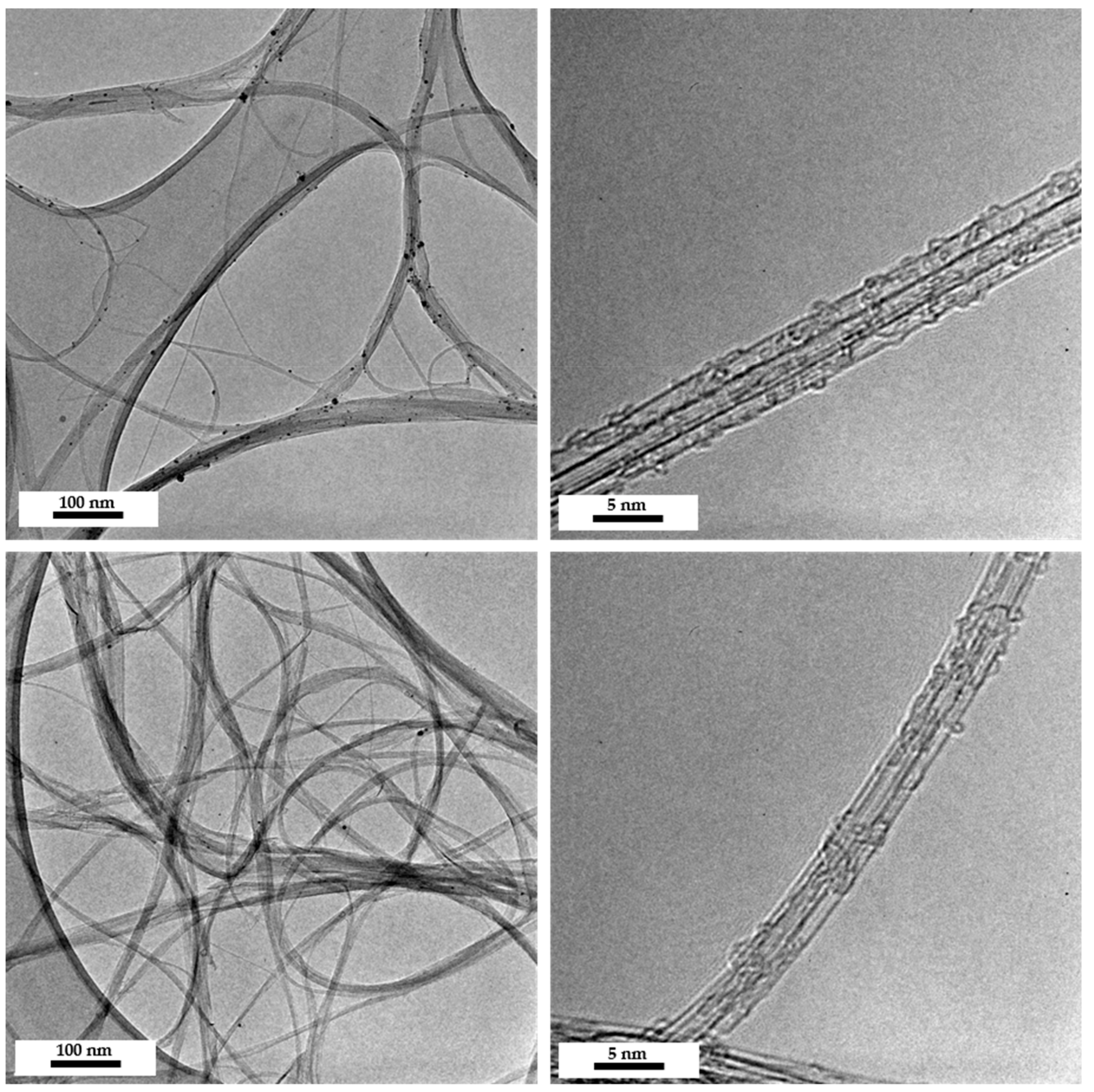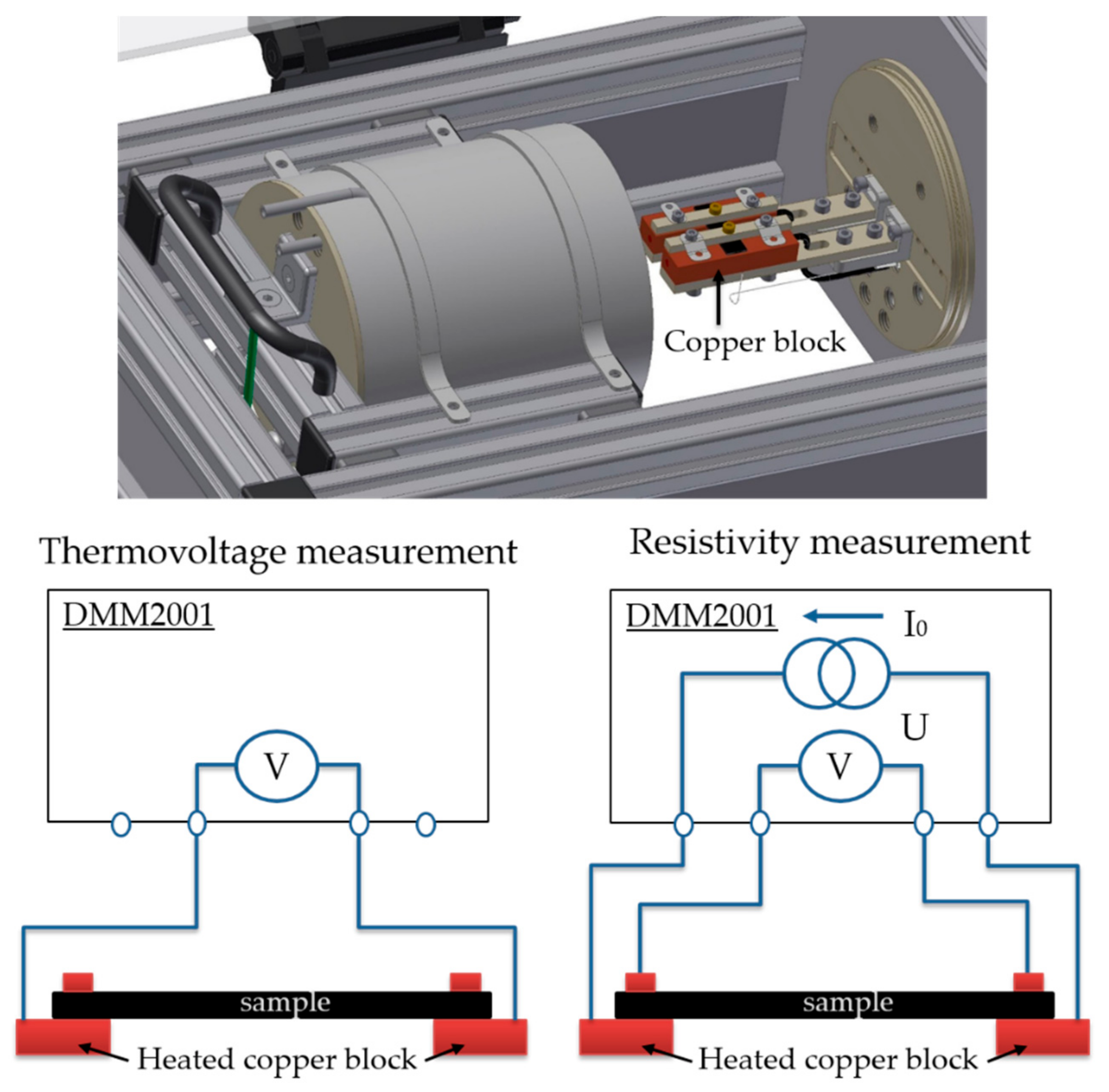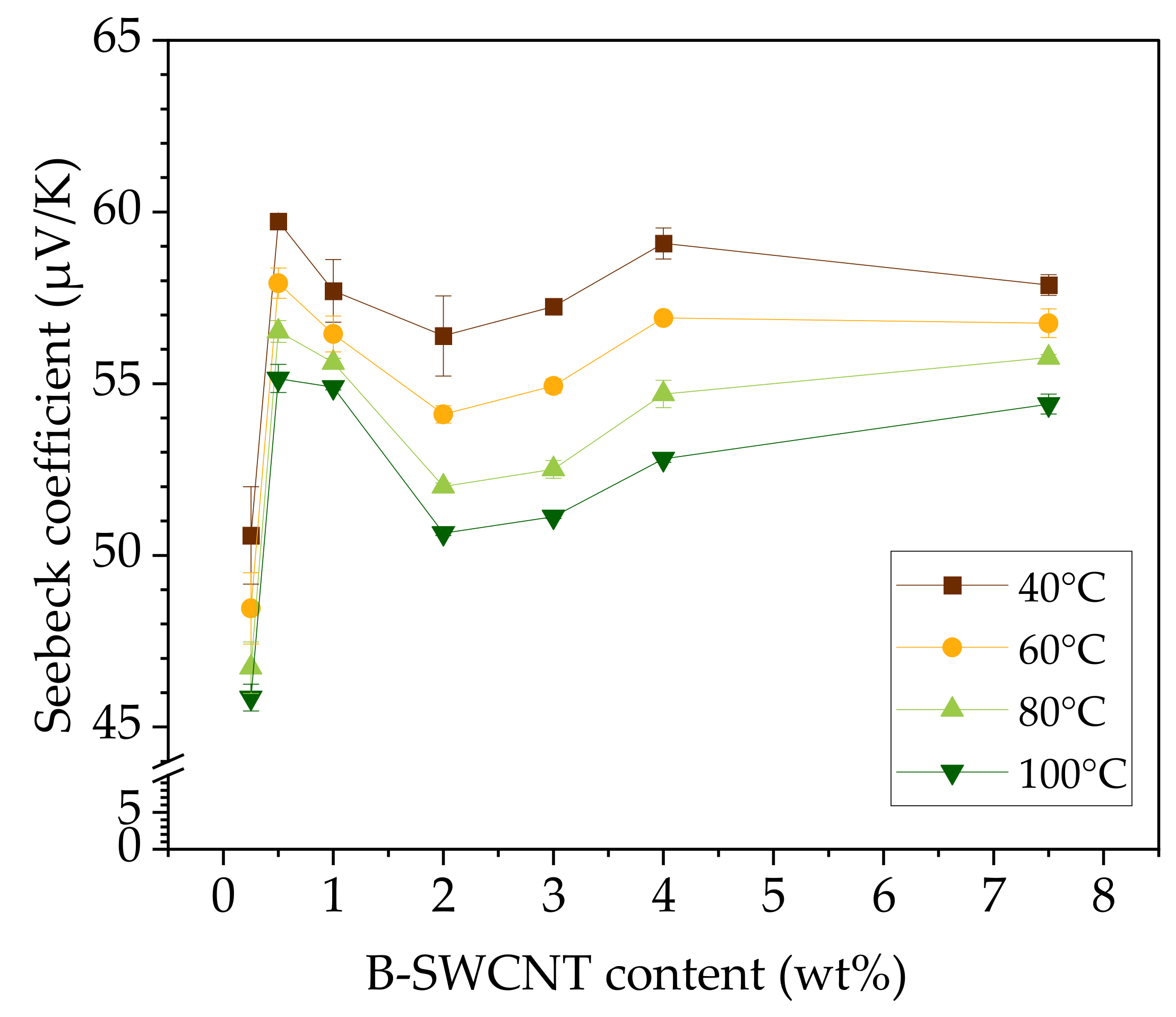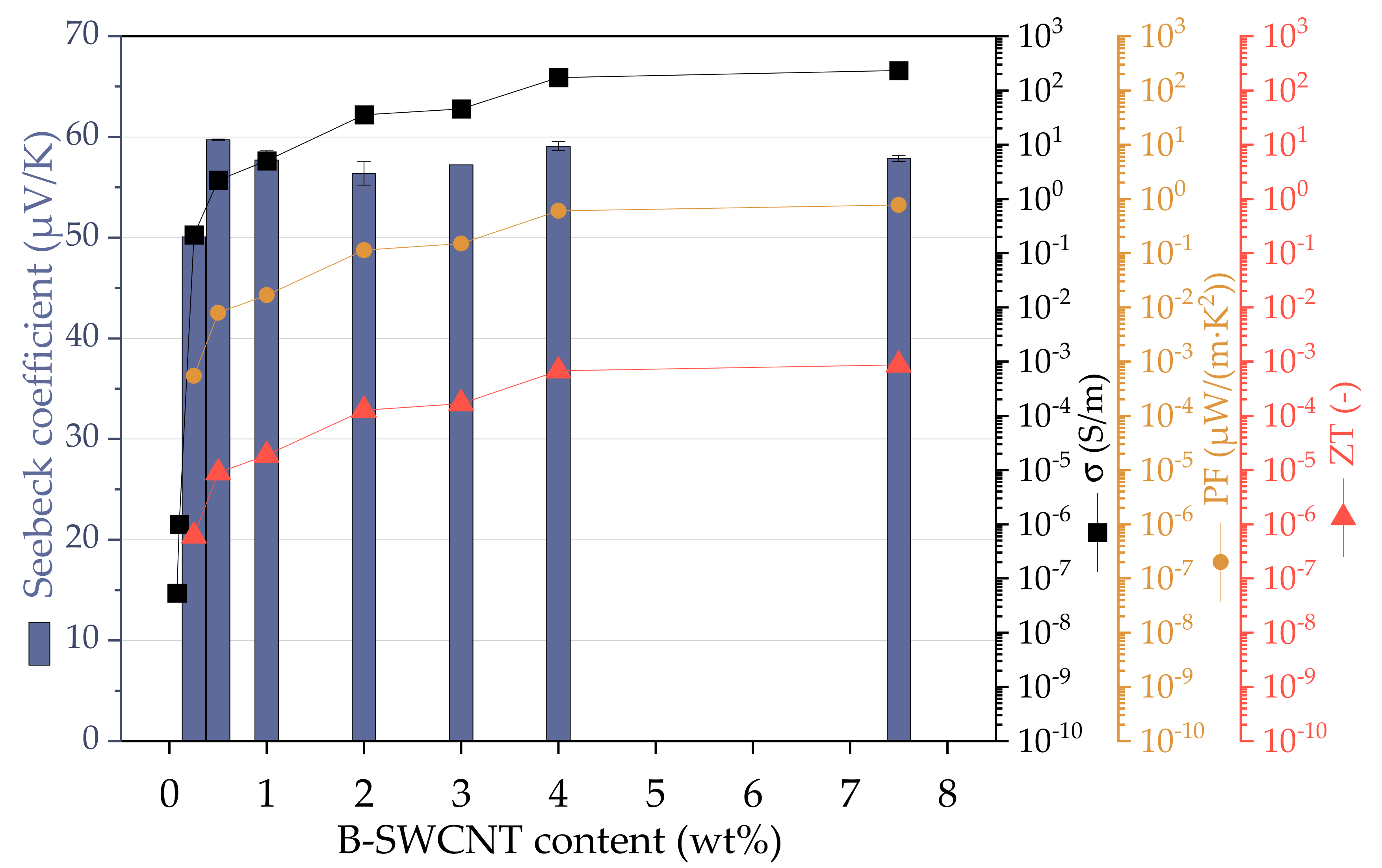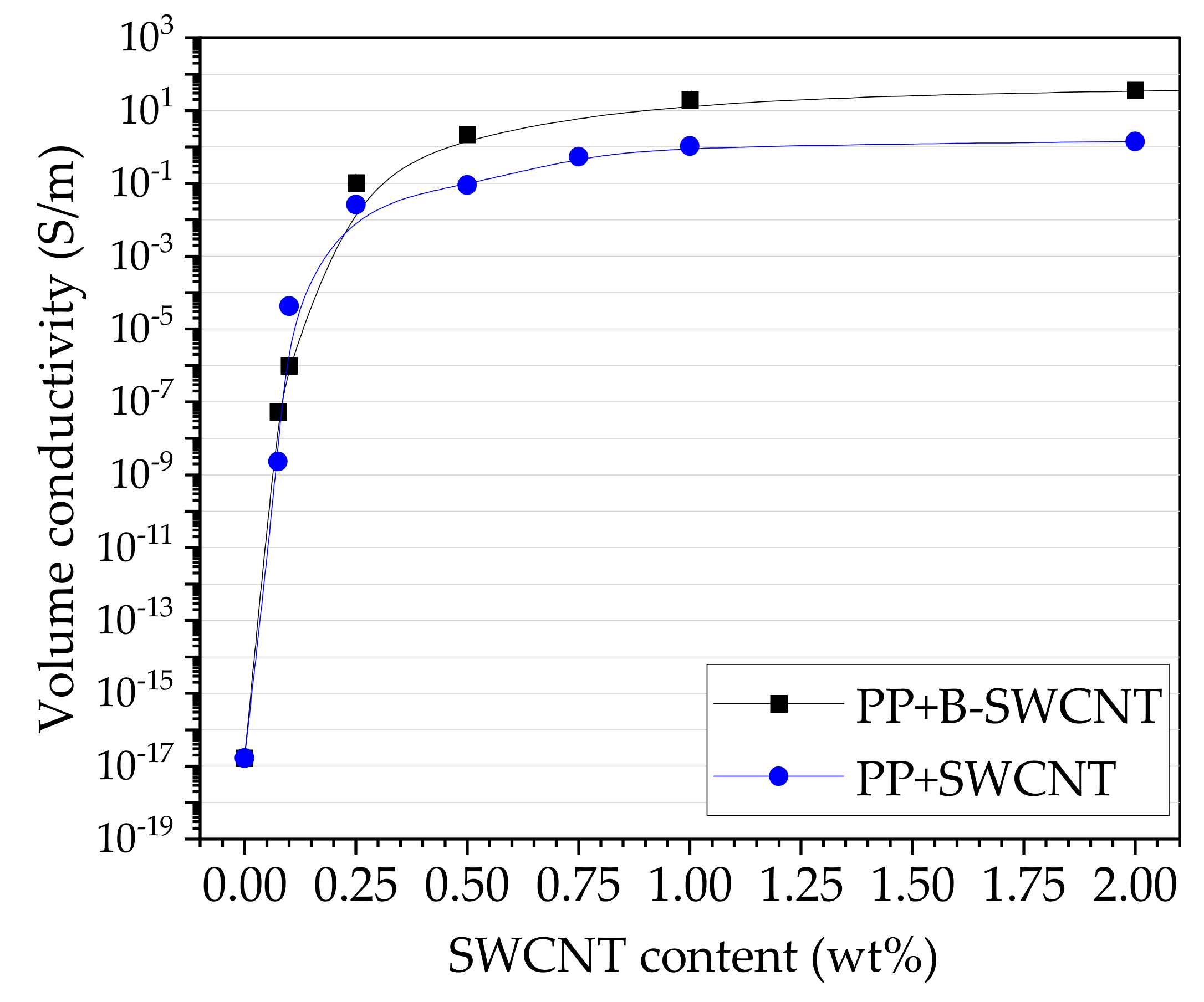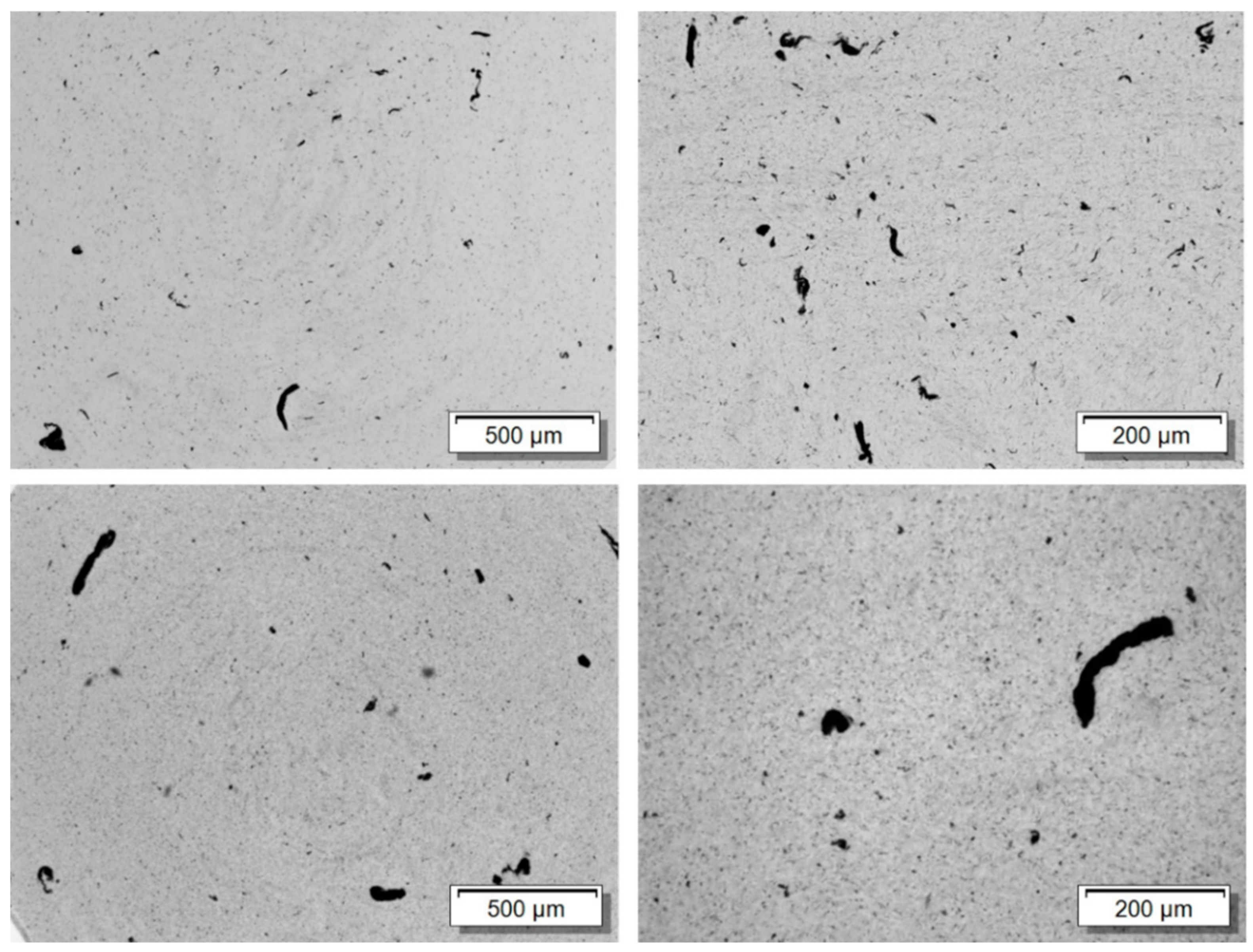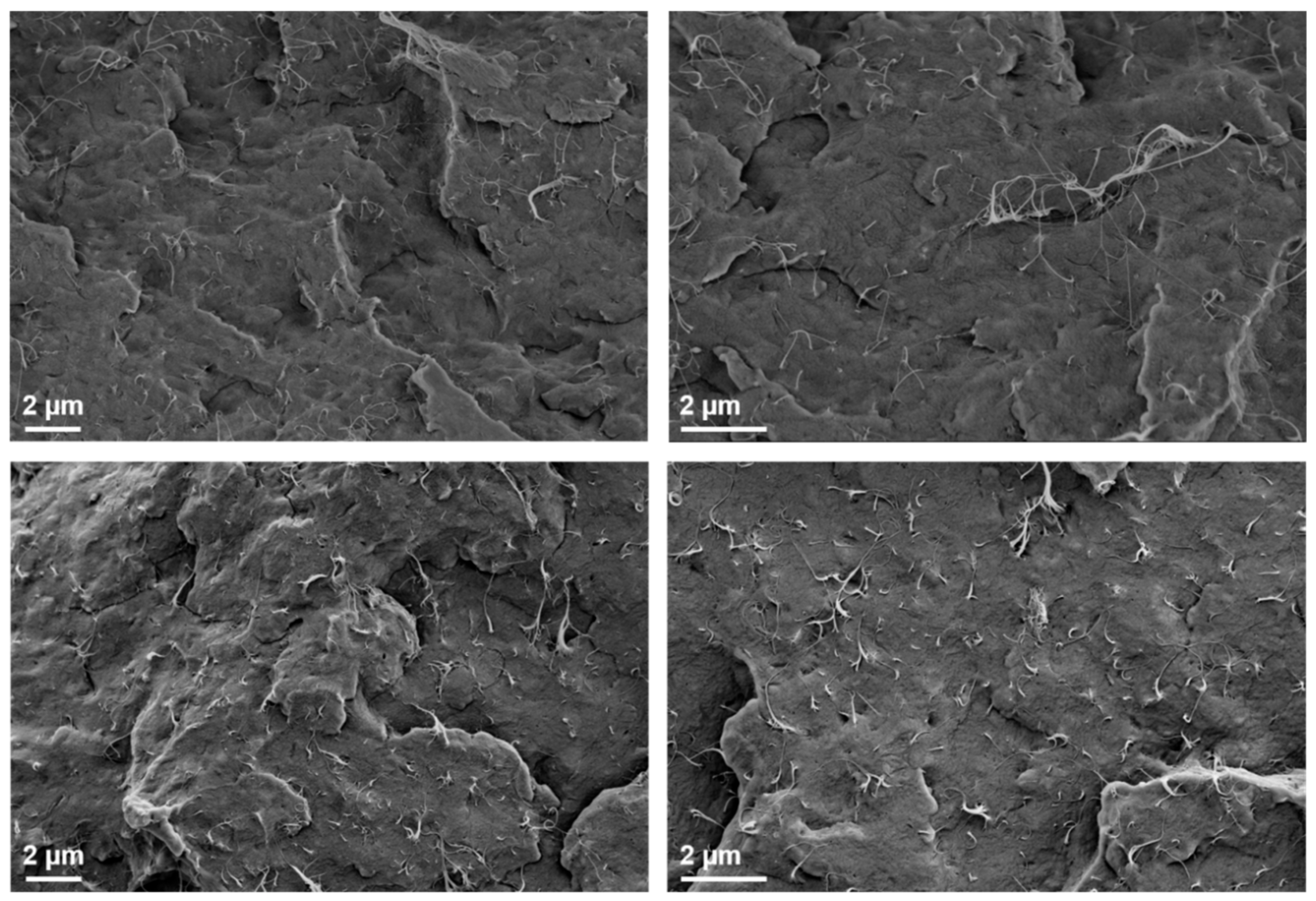1. Introduction
The use of waste heat energy to generate voltage according to the thermoelectric (TE) principle is a well-known approach [
1,
2,
3]. In addition to the metal alloys commonly used in the past [
4], new thermoplastic polymer-based materials are becoming increasingly important [
5]. On the one hand, the advantage of polymeric materials lies in their low cost, mechanical flexibility, and easy formability, and on the other hand, in the intrinsically low thermal conductivity of polymers. Along with intrinsically conductive polymers, like PEDOT:PSS, PANI, or P3HT, composites of non-conducting polymers with conductive fillers have been developed. Different electrically conductive carbon-based filler materials, such as carbon nanotubes (CNTs), graphite, or graphite nanoplatelets (GNPs), can be added to introduce electrical conductivity in the materials, which is needed for the TE effect. If they are added in a quantity such that a connected path consisting of conductive fillers is formed, they are electrically percolated and behave like a conductor. Among the techniques possible to introduce such fillers in polymeric matrices, melt-mixing has significant advantages over solution-mixing. Namely, it can be easily upscaled and it is more environmentally friendly as no solvents are needed. Examples of this new kind of melt-mixed composites are polypropylene (PP) composites filled with single-walled carbon nanotubes (SWCNT) [
6,
7,
8,
9,
10], polyetherimide/SWCNT nanocomposites [
11], polycarbonate/multi-walled carbon nanotube (MWCNT) composites [
12,
13,
14], polylactic acid (PLA)-based composites containing Bi
0.5Sb
1.5Te
3 and/or MWCNTs [
15], PLA filled with MWCNT and/or expanded graphite [
16], and poly(vinylidene fluoride) (PVDF)-based polymer composite foams with MWCNTs or GNPs [
17]. In a recent paper, screening of different kinds of CNTs in different polymeric matrices was performed, showing that a variety of TE properties can be achieved when varying CNT and polymer type [
18].
For the construction of a TE generator able to generate a thermovoltage based on a temperature difference, n- (electron-donating) as well as p-type (electron-withdrawing) materials are needed. One way to influence of p-/n-behavior of composite material is the selection of semiconducting SWCNT types [
19,
20,
21]. SWCNTs easily absorb molecular oxygen from the environment, which attracts electrons and typically leads to p-type SWCNTs [
19,
22]. On the other hand, such kind of doping may become unstable if SWCNTs are processed at elevated temperatures or under vacuum conditions. A substitutional doping of SWCNTs with boron (B) atoms, where B replaces some of the carbon (C) atoms in the hexagonal lattice of SWCNT walls, is more stable and leads to an increase in both the Seebeck coefficient and electrical conductivity of SWCNT networks [
23]. Furthermore, large amounts of B-doped SWCNTs can be produced with a post-synthesis treatment of pristine SWCNTs, which is important in regard to the application of such material in thermoelectric applications.
In the literature, studies of composite materials filled with boron-doped carbon nanotubes are very rare. Kumanek et al. [
24] described temperature-dependent thermoelectric measurements on ethyl cellulose/doped MWCNT films in the range from 30 to 100 °C. It has been reported that the Seebeck coefficient for ethyl cellulose/B-doped MWCNT was almost constant at around 23 µV/K. This represents a significant increase in the Seebeck coefficient compared to undoped MWCNTs for which a Seebeck coefficient of −1.5 µV/K was measured. By contrast, n-type doping of SWCNTs is a challenge in terms of doping stability. Various types of doping are described in the literature, e.g., polymer coating, charge transfer from polymer chains to the CNTs, encapsulation of organometallic materials in the nanotubes, doping by salt anions with countercations, or nitrogen input [
19,
20,
24,
25].
The performance of a TE material is evaluated by different parameters, such as Seebeck coefficient S, power factor PF, and figure of merit ZT.
The Seebeck coefficient
S is calculated by
where
U is the measured thermovoltage at a temperature difference
dT. A negative Seebeck coefficient indicates n-type material and a positive Seebeck coefficient p-type material.
The power factor (
PF) is also commonly used as a performance parameter since it is directly related to the usable power that can be achieved. The
PF is calculated by
where
S is the Seebeck coefficient and
σ is the electrical conductivity.
The third parameter is the dimensionless figure of merit
ZT and it is defined as
where
S is the Seebeck coefficient,
σ is the electrical conductivity,
T is the absolute temperature, and
κ the thermal conductivity.
In order to achieve high TE performance, a high Seebeck coefficient S, high electrical conductivity σ, and low thermal conductivity κ are desirable. However, these parameters are heavily interrelated, and optimization is a challenge.
In the present study, boron-doping of SWCNTs was performed and these B-SWCNTs as well as the comparable raw SWCNT material were incorporated into polypropylene (PP) using melt-mixing at a small scale. The thermoelectric properties of the PP composites were measured and discussed. Additionally, the PP/SWCNT composites were characterized regarding nanotube dispersion at the macro- and nanoscale, electrical properties, and thermal behavior.
2. Materials and Methods
For the polymer matrix, polypropylene (PP) of the type Moplen HP 400R (LyondellBasell Industries, Rotterdam, The Netherlands) was used with a melt flow rate of 25 g/10 min @230 °C, 2.16 kg.
The single-walled carbon nanotubes (SWCNTs) Tuball
TM grade 75% (OCSiAl Europe, Leudelange, Luxembourg) selected for this study had a length exceeding 5 µm [
26], a bulk density of 0.09 g/cm
3 [
27], and surface area of 331 m
2/g [
27].
The SWCNTs and diboron trioxide powders (B
2O
3, >98%, Sigma-Aldrich, St. Louis, MO, USA) were mechanically mixed at a weight ratio of 1:5 in a graphite crucible and then processed at 1300 °C in argon atmosphere as described elsewhere [
23,
28]. The boron-doped SWCNTs were boiled in excess deionized water and filtered to remove the unreacted B
2O
3. The obtained B-SWCNT paste was directly dried using a freeze dryer (Christ Alpha 1-4 LSCplus, Fisher Scientific GmbH, Schwerte, Germany). This approach was used to avoid formation of large SWCNT agglomerates during drying in ambient conditions. No extra processes, such as ultrasonication, were performed in an attempt to further break the SWCNT bundles, as such processes could cause structural damage of B-SWCNTs and deterioration of their electrical properties. After boron doping, 8% of boron, in total, was introduced to the SWCNTs in the form of B
2O
3, BCO
2, BC
2O, BC
3, and B
4C, as characterized by X-ray photoelectron spectroscopy (XPS) [
23,
28]. Boron doping leads to an increase in electrical conductivity by 1.6 times (up to 2.2 × 10
5 S/m) compared to undoped SWCNTs (1.4 × 10
5 S/m), as measured in SWCNT films [
23,
28]. Freeze-dried B-SWCNTs in dry powder form were directly used for melt-mixing with PP polymer.
High-resolution transmission electron microscopy (TEM) was performed with the TEM Tecnai F30 (Thermo Fisher Scientific, Waltham, MA, USA). The TEM samples were prepared by drop casting a dispersion of SWCNT powders in ethanol onto copper grids (S147-3, PLANO GmbH, Wetzlar, Germany). Small bundles of SWCNTs were observed in the TEM for both samples (
Figure 1). The pristine SWCNTs have diameters of about 2 nm with non-smooth surfaces, possibly loaded with amorphous or nanoscale crystallized carbons originating from the production process. After the high-temperature doping process, the SWCNTs show intact tubular structures, with the carbon-containing structures remaining on the walls of the nanotubes.
Thin films were produced to demonstrate the thermoelectric properties of the SWCNTs themselves, as described in Liu et al. [
29]. In detail, either pristine SWCNTs or B-SWCNTs (1 wt%) were dispersed in water with addition of 0.1 wt% of sodium cholate as surfactants (sodium cholate hydrate, >99%, Sigma-Aldrich, St. Louis, MO, USA). Stable SWCNT dispersions were obtained after tip sonication for 1 h (Branson Ultrasonics Sonifier™ S-250D, in 40% power, Fisher Scientific GmbH, Schwerte, Germany) and then ultracentrifugation for 30 min using 268,240×
g centrifugal force (Beckman Coulter-Optima Max, Beckman Coulter GmbH, Krefeld, Germany) to remove sediments. A SWCNT film was firstly prepared on the top of a filter using vacuum filtration of the SWCNT dispersion through a polycarbonate filter membrane (Whatman “Nuclepore” track-etched polycarbonate hydrophilic membrane, diameter 25 mm, pore size 100 nm, Fisher Scientific GmbH, Schwerte, Germany). Then, the deposited SWCNT film was transferred to a glass substrate by covering the filter upside down on the glass substrate and dissolving the filter membrane with N-methyl-2-pyrrolidone (≥99%, Sigma-Aldrich, St. Louis, MO, USA). The films were annealed in hydrogen (H
2) atmosphere (400 °C, 15 min) to reduce possible oxygen-containing functional groups and to remove adsorbed water from the surface of B-SWCNTs. Thermoelectric parameters of the film samples were measured with a commercial setup (SRX, Fraunhofer IPM, Freiburg, Germany). The samples of SWCNT films used for thermoelectricity measurements had a rectangle shape (24 × 10 mm
2). For Seebeck coefficient measurements, the samples were clamped on a heater powered by a power supply (EA-PS 8065-10) under the control of a Nanodac
TM T-controller (Eurotherm, Schneider Electric Systems Germany GmbH, Limburg an der Lahn, Germany). The applied temperature gradient along the sample is 3–5 K, depending on the thermal conductivity of the sample. To ensure proper contact, a linear behavior of I–V curves was checked. The inherent error of the Seebeck coefficient setup is <10%. A 4-point-probe configuration was used for electrical conductivity measurements. The applied current was retained below 50 mA to minimize the effects of Joule heating.
Melt-mixing of PP/SWCNT composites was performed in a small-scale conical twin-screw micro compounder Xplore DSM 15 (Xplore, Sittard, The Netherlands) having a volume of 15 ccm using a mixing temperature of 210 °C, rotation speed of 250 rpm, and mixing time of 5 min. The materials were fed together in the running compounder and, after the set mixing time, were discharged into the air as a strand through a nozzle with a diameter of approx. 2 mm without additional cooling.
The composites were compression molded to plates having a diameter of 60 mm and a thickness of 0.5 mm using the hot press PW40EH (Otto-Paul Weber, Remshalden, Germany) at 210 °C for 2 min followed by cooling using a minichiller for 30 s. Strips cut from such plates were used for measurements of electrical resistivity as well as thermoelectric properties.
Morphological characterization of the PP/SWCNT composites was performed using scanning electron microscopy (SEM) by means of Ultraplus microscope (Carl Zeiss GmbH, Oberkochen, Germany, field emission cathode). The composite strands were cryofractured in liquid nitrogen and prior to observation, the surfaces were covered with 3 nm platinum.
For evaluation of SWCNT macrodispersion by transmission light microscopy (LM), the extruded composite strands were cut into thin sections with a thickness of 5 µm using the microtome Leica RM2265 (Leica Mikrosysteme Vertrieb GmbH, Bensheim, Germany) at room temperature and were fixed using an Aquatex adhesive on glass slides. The LM investigations were performed using a microscope BX53M combined with a camera DP71 (Olympus Deutschland GmbH, Hamburg, Germany). The agglomerate ratio AA (%) of the area of filler agglomerates related to the total area of the images was calculated to quantify the remaining SWCNT agglomerates in the PP matrix.
Differential scanning calorimetry (DSC) was performed to characterize the thermal properties of the PP-based composites using a Discovery DSC2500 (TA-Instruments, New Castle, DE, USA) in the temperature range of −80 to 200 °C at a scan rate of ±10 K/min. Samples of about 5 mg were investigated under nitrogen atmosphere in a heating–cooling–heating cycle. The melting temperature Tm was calculated from the second heating run. The crystallinity α was calculated from the cooling enthalpy ∆Hc which was related to the enthalpy of 207 J/g for 100% crystalline polypropylene.
The Seebeck coefficient (S) and volume resistivity were determined using the self-constructed equipment TEG at Leibniz-IPF [
30,
31] (
Figure 2). The measurements were performed at 40, 60, 80, and 100 °C with temperature differences between the two copper electrodes up to 7–8 K. The samples were painted with conductive silver at their ends. The volume resistivity was measured using a 4-wire technique. The measurement of voltage and resistance was performed using Keithley multimeter DMM2001 (Keithley Instruments, Cleveland, OH, USA). The given values represent the mean values of three measurements. The figure of merit ZT was calculated using a value for the thermal conductivity of PP composites of 0.28 W/(m·K) [
32,
33,
34]. The same instrument was used to measure the electrical conductivity and Seebeck coefficient of the SWCNT powders. For this, an insert consisting of a PVDF tube (inner diameter 3.8 mm, length 16 mm) closed with copper plugs was used, which was filled with the SWCNT powder [
18]. The final SWCNT package had a length of 6 mm. The measurements were performed at 40 °C with temperature differences between the two copper electrodes up to 8 K.
3. Results
The thermoelectric properties of the PP/SWCNT composites were compared with the values achieved on thin SWCNT films and the powder packages. The Seebeck coefficients of solution prepared thin films of pristine SWCNT and B-SWCNT materials were 24 and 32 µV/K (at room temperature), respectively. The corresponding electrical conductivity and therefrom calculated PF were 145,000 S/m and 85 µW/(m·K
2) for pristine SWCNT films and 214,000 S/m and 226 µW/(m·K
2) for B-SWCNT films [
23]. For pristine SWCNT and B-SWCNT powders, electrical conductivities of 1790 [
18] and 1810 S/m and Seebeck coefficients of 39.6 ± 0.2 [
18] and 42.2 ± 0.1 µV/K were measured. This results in PF values of 2.81 [
18] or 3.23 µW/m·K
2, respectively. The values obtained for the SWCNTs by the two measuring methods show significantly lower electrical conductivities and slightly higher values for the powder packages than for the thin films, which may derive from the different preparation methods and packing densities in both cases and the different equipment and measuring conditions used. However, for both methods, the results indicate a significant increase in the Seebeck coefficient and PF values with the incorporation of boron in the molecular structure of the SWCNTs. The existing p-type character of the SWCNTs is strengthened by boron-doping.
The Seebeck coefficients of PP/B-SWCNT composites as studied at different temperatures of 40, 60, 80, and 100 °C are shown in
Figure 3. Thermoelectric measurements were already possible at the very low concentration of 0.25 wt% B-SWCNT. As expected, the Seebeck values were positive indicating p-type character of the PP-based composites. On the one side, the Seebeck coefficient generally decreases with temperature for all B-SWCNT contents in PP. In the investigated temperature range, the volume conductivity increases by a maximum of 10% for each B-SWCNT content. This means that a stable CNT network has already formed which is minimally dependent on temperature changes. On the other side, the Seebeck coefficient increases between 0.25 and 0.5 wt% B-SWCNT content by around 10 µV/K, and levels off at higher B-SWCNT contents in PP. The highest value achieved is 59.7 µV/K for the composite with 0.5 wt% B-SWCNT (@40 °C).
Based on the Seebeck coefficient, electrical volume conductivity, and thermal conductivity, the power factor PF and figure of merit ZT for all PP/B-SWCNT composites were calculated (
Figure 4). The volume conductivity of the PP composites increases with the B-SWCNT content. Consequently, with increasing B-SWCNT content, the PF and ZT of the PP composites increase up to values of 0.78 µW/(m·K
2) and 0.001, respectively. At filling levels between 4.0 and 7.5 wt% B-SWCNT, the values of PF and ZT reach their maximum values; it appears that increasing the amount of B-SWCNT above 4.0 wt% no longer increases the values.
The comparison of PP/B-SWCNT composite materials with those containing the unmodified base SWCNTs is shown in
Table 1, which lists the thermoelectric parameters S, PF, and ZT of composite materials with 0.25–2 wt% SWCNTs. It should be noted that the composite preparation conditions by melt compounding followed by compression molding as well as the applied PP grade and thermoelectric measurement procedure were identical for all specimens between this study and the results in [
32] which were selected for this comparison. For PP composites with B-SWCNTs, the Seebeck coefficient, power factor, and figure of merit ZT were always higher than for composites with pristine SWCNTs. This seems to be a general trend. These results show that also for PP composites, the boron doping of SWCNTs leads to a more pronounced p-type thermoelectric character.
The most significant difference between the SWCNT thin films and the corresponding PP composites is the very different electrical conductivities. The SWCNT film shows a conductivity of 145,000 S/m, whereas the composites have a maximum value of 12.1 S/m (2 wt% loading). The B-SWCNT film has a conductivity of 214,000 S/m and its PP composite has 35.8 S/m (2 wt% loading) or 232.3 S/m (7.5 wt% loading). This enormous difference is due to the wrapping of polymer chains around the nanotubes, resulting in increased contact resistance at the touching points. On the other hand, the Seebeck coefficients of the composites are higher than those of the SWCNT films and predominantly higher than those of the powder packages which indicate that the surrounding polymer matrix shows an effect on the p-doping characteristics of the nanotubes. Whereas the SWCNT film exhibits a Seebeck coefficient of 26 µV/K, and for the powdered package, 39.6 µV/K, the values of the PP composite materials with a CNT content of 0.5 wt% or more are between 44.2 and 47.9 µV/K. For B-SWCNT, the value of the film is 31 µV/K and that of the powder package 42.2 µV/K, while the PP composites show values between 50.1 and 59.7 µV/K. This finding of increased Seebeck coefficients of polymer-bound nanotubes correlates with results of a study by Piao et al., who infiltrated SWCNT buckypapers (of another SWCNT type) having p-type character with polymer solutions of the different polymers, like PVDF, polycarbonate (PC), poly(methyl methacrylate) (PMMA), poly(vinyl alcohol) (PVA), and polystyrene (PS). The Seebeck coefficient increased from 38 to about 50 µV/K due to polymer penetration with simultaneous negative impairment of the electrical conductivity.
It is expected that the different properties of the two SWCNT types will also influence their electrical percolation behavior. The dependence of the electrical volume conductivity on the filler content of PP composites with SWCNTs [
27] and boron-doped SWCNTs is compared in
Figure 5. Both types of SWCNTs show an electrical percolation threshold in PP of about 0.075–0.1 wt%. This is, comparatively, a very low percolation threshold [
35]. In the plateau area of electrical volume conductivity, PP/B-SWCNT composites exhibit about one order of magnitude higher conductivity values than PP/SWCNT composites.
It is well known that the electrical percolation behavior of CNTs in polymer matrices strongly depends on the state of nanotube dispersion. The more nanotubes are individualized from the primary SWCNT agglomerates produced, the more perfect the conductive network will be. This results in a lower electrical percolation threshold and higher electrical conductivity. Thus, the SWCNT macrodispersion in PP composites was characterized by transmission light microscopy on thin sections (
Figure 6). In both composite materials, remaining SWCNT agglomerates could be observed in the PP matrix. However, the remaining agglomerates of B-SWCNTs were smaller than those of SWCNTs. The better dispersion of B-SWCNT in PP is also indicated by a lower agglomerate area ratio A
A of 1.0% ± 0.4% compared to A
A = 1.6% ± 0.7% for PP/SWCNTs [
32].
To characterize the SWCNT dispersion in the microscale, cryofractured surfaces of PP composites were observed using SEM (
Figure 7). At this magnification, well-distributed long CNTs were visible, with no significant differences between the two SWCNT types.
It is widely known that nanotubes can induce crystallization in partially crystalline polymers like PP [
36]. Thus, the effect of both SWCNT types on the melting and crystallization behavior of PP composites was analyzed using DSC measurements. The results are summarized in
Table 2. As expected and has been well described in literature [
26,
36,
37,
38], the melting temperature T
m as well as crystallization temperatures at onset T
c,onset and maximum T
c,max increase with incorporation of CNTs. The overall crystallinity α of PP increased with SWCNT addition from 46% up to 51–52%. For all composites, the overall crystallinity was in the same range for both PP/SWCNT composites. Interestingly, as can be seen on the T
c,onset and maximum T
c,max, the nucleation effect was more pronounced with B-SWCNTs as these composites have higher crystallization temperature values during the cooling of the composites. The crystallization process starts at 139 °C for the composite with 1% B-SWCNT compared to 135 °C for PP with 1 wt% SWCNT. The maximum crystallization temperature T
c,max was also 5 K higher for the composite with B-SWCNT than for PP/1 wt.% SWCNT.
In addition, it was investigated whether the grade of the polypropylene matrix has an influence on the thermoelectric properties of the composites (
Table 3). Therefore, different grades from different producers were selected which have almost the same melt flow rate ranging between 25 g/10 min and 47 g/10 min (@230 °C, 2.16 kg). Thus, based on the expected similar melt viscosities and shear stresses acting on the primary SWCNT agglomerates during melt-mixing, no significant differences in the state of SWCNT dispersion and electrical properties of the composites were expected. However, the results show that the electrical conductivity as well as the Seebeck coefficient differs at the same SWCNT concentration, even if mixing, compression molding, and measuring conditions were the same. For example, at 0.25 wt% SWCNT loading, depending on the PP grade, the Seebeck coefficient values are between 35.0 and 50.5 µV/K. The PP composites based on the grade PP 579S seems to have always the highest S, PF, and ZT values. This is the grade with the highest melt flow rate, meaning with the lowest melt viscosity during mixing. In order to clarify the reason for these differences, more investigations are also needed considering the state of SWCNT dispersion in the different grades and the differences in PP crystallinity.
4. Summary and Discussion
PP composites filled with SWCNTs and B-SWCNTs were prepared to analyze the influence of boron-doping of SWCNTs on the thermoelectric properties of PP composites. Thereby, the boron doping of SWCNTs represents an easily performed post-synthesis treatment of pristine SWCNTs and can be scaled to produce large amounts of B-doped SWCNTs. It was found that a significantly higher Seebeck coefficient could be measured not only for B-SWCNT films and powder packages, but also for PP composites, and the values for incorporation of B-SWCNT were higher than for SWCNTs. Due to the higher electrical conductivity and the higher Seebeck coefficients, PF and ZT were also higher for the PP/B-SWCNT composites. The highest value achieved in this study was a Seebeck coefficient of 59.7 µV/K for PP with 0.5 wt% B-SWCNT. However, this high value could also be achieved by varying the PP type to one with very low melt viscosity, where the addition of 0.5 wt% of pristine SWCNTs also resulted in a value of 59.8 µV/K. The highest power factor of this study of 0.11 µW/(m·K2) was achieved at 2 wt% B-SWCNT addition, which also resulted in the highest ZT value of 1.3 × 10−4.
The macro- and nanodispersion of the SWCNT in the composite (
Figure 6 and
Figure 7) can be excluded as a cause for the different conductivities and Seebeck coefficients between B-SWCNTs and SWCNTs in the same PP type, since no significant differences were found. With regard to the electrical properties, the same very low electrical percolation threshold at 0.075 to 0.1 wt% was determined for both SWCNT types. However, at higher SWCNT contents, the volume conductivity of PP/B-SWCNT composites is about one order of magnitude higher than that of PP/SWCNT. The investigation of the thermal behavior of the composite materials showed that crystallization in PP/B-SWCNT composites starts at significantly higher temperatures than in PP/SWCNT. However, the total crystallization in both composites is almost identical.
In summary, it can be concluded that boron doping is the most likely cause for the different thermoelectric properties, in particular, the higher Seebeck coefficient. However, it cannot be excluded that the higher crystallization temperatures found with the addition of B-SWCNT, which indicate a changed PP crystallite structure, also have an influence on the thermoelectric properties. From the higher Seebeck coefficient values of the PP/B-SWCNT composites, it can be deduced that with boron doping, the p-character (electron deprivation) of the SWCNTs was also successfully strengthened in the PP-based composites.
Furthermore, it was also shown that the grade used for the PP matrix has a major influence on the thermoelectric properties of PP/SWCNT composites. This indicates that not only the electrically conductive SWCNT network, but also the interaction between the PP matrix and the SWCNTs have to be considered. Possibly, the crystallinity and the crystallization temperatures of PP play a role. Voigt [
36] found that total PP crystallinity increased from 54% to 56% with the addition of 0.5 wt% SWCNT to PP of type HG475FB. The crystallization temperature simultaneously increased by 12.7 K (from 119.7 to 132.4 °C), which represents a significantly higher increase than for the PP grade investigated here (
Table 2). The cause of the PP influence on different composite properties has to be revealed in further investigations.
